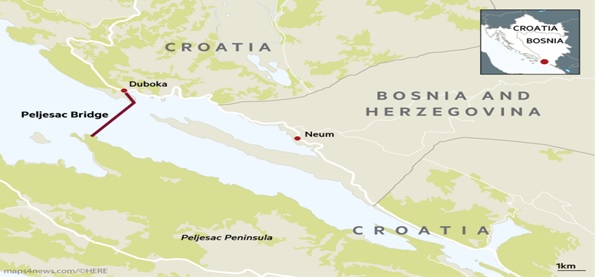
Senad SEVDİK
Scholar in Residence, Center for Eurasian Studies (AVİM)
Introduction
Historically, the Republic of Ragusa/Dubrovnik ceded Neum-Klek peninsula and Sutorina coast areas to the Ottoman Empire in the Treaty of Karlovci of 1699.[1] However, only Neum town is still under the territory of BiH in our present time. Nowadays, the Pelješac bridge project threatens the legal rights of Bosnia and Herzegovina’s (BiH) access to open seas. The Pelješac bridge aims to achieve the Republic of Croatia and the European Union’s territorial continuity by connecting the Dubrovnik-Neretva county with the remainder of the Croatian mainland.[2] Both Croatia and BiH failed to ratify the Neum agreement in 1998, and Croatia’s EU membership in 2013 further deteriorated the border issues. This article will analyze the Pelješac bridge in terms of the EU’s destabilization process in the Balkans, BiH’s tripartite Presidency members’ speeches, legal maritime access of Neum city and Turkey’s possible solutions for preventing Pelješac bridge.
European Union’s Destabilization in Balkans
‘‘Balkanization’’ is defined as the fragmentation of multinational states into smaller ethnically homogeneous territories. This has been evident since the 1990s in the Balkans. Unfortunately, this destabilization continued with “Europeanization of Balkans” since the EU accepted Slovenia and Croatia into the European Union in 2004 and 2013 respectively. However, all other Balkan countries need to be first “Europeanized” in order to be accepted into the European Union.[3] Although EU expects Balkan countries to solve their border conflicts with their neighbours, it intentionally supports Pelješac bridge and worsens “good neighbourly relations of Croatia and BiH” by taking Croatia into EU and leaving BiH to its fate. Therefore, BiH’s sovereignty is threatened now by its neighbours of Croatia, Serbia and their allies of Germany or the EU and Russia. Additionally, EU ironically finances 85% of the construction cost of Pelješac bridge which is being built by China for satisfying Croatia’s EU condition of “full Schengen control regime”.[4] EU granted €357 million to Croatia for the construction of the bridge in 2017 which is expected to end in 2022.[5]
Although the clearance below of the bridge is altered from 35 to 55 meters, it still closes BiH’s right to access open seas and violating United Nations Convention on the Law of the Sea (UNCLOS). Hence, Bosnian MPs wrote a letter to EU foreign policy chief Federica Mogherini and to the international representative in BİH, Valentin Inzko that Croatia is violating the sovereignty of BiH without the formal consent of BiH Presidency. BiH presidency official argued that the European Commission even did not consult BiH for their bilateral relations with Croatia.[6] Therefore, although bilateral disputes of neighbour countries must be solved before the EU accession, the EU even ironically causes an escalation of bilateral dispute among neighbours. In this context, it is worth remembering the retired Turkish Admiral Cem Gürdeniz’s assessment that Pelješac is the EU’s geostrategic project and that the EU does not want a BiH with access to open seas or BiH’s presence in the region.[7]
BiH’s Tripartite Presidency Members’ Speeches
The biggest obstacle for solving the Pelješac project in BiH’s domestic politics is the lack of common consensus among political parties because currently the Serb member of the Presidency of Bosnia and Herzegovina, Milorad Dodik’s support to the project and his alliance with Croatians. Dodik adds that he would utilize the “vital entity interest card” for blocking lawsuit if it is necessary for protecting Bosnian Serbs’ interests. The Prime Minister of Croatia, Andrej Plenković stressed that Pelješac bridge would guarantee and ensure Croatia’s territorial connectivity forever. Bakir Izetbegović, the President of SDA party stresses that they acknowledge the right of Croatia to connect parts of its territory, however, BiH’s right to have access to the open sea should not be ignored.[8] Croatian member of BiH Presidency, Željko Komšić argued that “It is not only the Pelješac bridge in dispute but also the sea border with Croatia.” So that we can have access to the open sea. This is also approved the Bosniak Member of the Presidency of Bosnia and Herzegovina by Šefik Džaferović.[9] Both Komšić and Džaferović argue that if Croatia rejects this offer, then they would go to International Court of the Law of Sea in Hamburg. However, BiH cannot sue Croatia since Milorad Dodik received more than two-thirds support (72%) in the National Assembly of RS and vetoed the lawsuit of Pelješac bridge. Therefore, Dodik’s approval vote is needed for opening a lawsuit to Croatia.[10] Additionally, the former President of European Commission, Jean-Claude Juncker, believes that BiH will not file a lawsuit to Croatia since Slovenia did not sue Croatia in the Hamburg, for its borders as well.[11] Therefore, BiH clearly does not have an ally in this region and Turkey is the best option for BiH to mediate on behalf of BiH since they are legally justified to stop the illegal project according to UNCLOS.
The Legal Maritime Access of Neum City
After the Badinter Commission Yugoslavia was decided to enter “in process of the dissolution”, the first boundary agreement between successor states has been achieved. The Treaty on the State Border between Republic of Croatia and Bosnia and Herzegovina was signed by the Croatian President, Franjo Tuđman and Alija Izetbegović, who was the member of the Presidency of Bosnia and Herzegovina in 1999. The agreement was signed on 30 July 1999 in Sarajevo. The state border between the countries is determined according to the borders at the end of Socialist Federal Republic of Yugoslavia in 1991. The sea border in the area of Neum and Klek peninsula is delimitated by way of an equidistance line. (see figure 1 below). Article 4 of the treaty states that the State border on the sea stretches along the central line of the sea between the territories of the Republic of Croatia and Bosnia and Herzegovina in accordance with the 1982 UN Convention on the Law of the Sea.[12] It is important to consider that both small islands near the Klek peninsula which are Mali Školj and Veliki Školj are given to BiH as well since they are so close to Klek peninsula. Although Croatia appears to recognize treaty and it is applied in good faith by both sides, this agreement is not ratified due to Croatians’ objections to two small islands which are given to BiH.
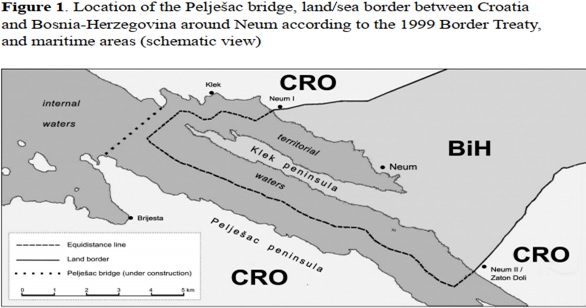
Source: Thomas Bickl, “Bridge over Troubled Waters: The Pelješac Project, China, and the Implications for Good-Neighbourly Relations and the EU,” Politička Misao : Časopis Za Politologiju 56, no. 3–4 (2019): 50–78, https://doi.org/10.20901/pm.56.3-4.03
However, BiH has always utilized the Croatian port of Ploče for its trading activites in this regard. In the UN Convention on the Law of the Sea, Article 7 argues that “The drawing of straight baselines must not depart to any appreciable extent from the general direction of the coast, and the sea lying within the lines must be sufficiently closely linked to the land domain to be subject to the régime of internal waters.”[13]However, Croatia has exploited Article 7 for maximum advantage, and hence now this causes problems for implementing Pelješac bridge. The UN Convention on the Law of the Sea also questions the legality of the Croatian’s straight baselines which run across the outer ends of the Dalmatian islands. These straight baselines of Croatia violate Article 7(6) of the UNCLOS since these straight baselines of Croatia intersect with another state such as BiH’s straight baselines. Therefore, BiH has warned and informed Croatia many times between 2007-2010 especially with the non-recognition of the straight baselines of Croatia between Cape Vodnjak Island and Cape Proizd Island (see figure 2 below). Article 8(2) of UNCLOS also allows BiH to have free innocent passage from open sea to Neum and vice versa.[14] Therefore, the Pelješac Bridge violates BiH’s sovereignty rights in three ways; firstly, since there is no clear ratified agreement between two countries, Croatia has to stop the construction of the bridge. Secondly, there had to be bilateral talks between two sides since UNCLOS give this right to BiH. Finally, Article 284. UNCLOS allows BiH to implement judicial procedure before ITLOS, ıf there was no reply from Croatia within 30 days. (Decision of the BiH Presidency, 16 July 2019).

Source: Thomas Bickl, “Bridge over Troubled Waters: The Pelješac Project, China, and the Implications for Good-Neighbourly Relations and the EU,” Politička Misao : Časopis Za Politologiju 56, no. 3–4 (2019): 50–78, https://doi.org/10.20901/pm.56.3-4.03
Therefore, BiH can initiate judicial procedure to ICJ and ITLOS against Croatia if and only if the Serb member of the Presidency of Bosnia and Herzegovina, Milorad Dodik approves the lawsuit decision. It should be mentioned that there were protests from Republika Srpska entity towards the 1999 treaty which were related to an island in the Una river between Hrvatska Kostajnica (Croatia) and Bosanska Kostajnica (BiH). Also, Dubrovnik county protested the agreement because of losing the Klek peninsula and its two of islands to BiH. However, BiH could not accept the latter protest since accepting this meant to be losing the status of maritime state for BiH and also the guaranteed rights of UNCLOS as well. All these two protests prevented the ratification of the 1999 treaty between Croatia and BiH, despite implementing the treaty in good faith for 14 years. As a result the Bosnian territorial sea will always be encircled by the Croatian internal waters. Hence, such interdependence can encourage between two sides towards transboundary cooperation peacefully, certainly without EU’s destabilization attempts. [15]
Turkey’s Possible Solutions For Pelješac Bridge
Turkey’s foreign policy towards the Balkans has been focused on security and stability, due to the Turkey’s liberal and Western orientations, whereas the Balkans’ security coincides with Turkey’s European aims.[16] According to Philip Robbins and Birgül Demirtaş, Turkey has pursued “soft power” in the politics of Balkan region concerning identity, linguistical, cultural, economic and migration issues rather than “hard power” or strategical military interests.[17] During the Bosnian war, Turkey was highly cautious for not perceiving this war as an “interfaith war" since this prespective could worsen the EU-Turkish relations. Turkey’s soft power was evident during the Bosnian war since Turkey was highly active for utilizing “The Organization of Islamic Cooperation” to end war through the United Nation’s channels. Therefore, Turkey’s “soft power” and “Western identity” allowed the implementation of stabilization attempts in Bosnia during the war, which consequently increased their reputation in the eyes of Europeans. Another example of Turkish soft power policy was its mediation role among Balkan countries at the Balkan conference in Istanbul in 1992. Süleyman Demirel’s -the Turkish President- letter to the United Nations Security Council’s members for removing arms embargo on Bosniaks, was another “stabilization” factor in this regard.[18] Moreover, the former Turkish Foreign Minister, Hikmet Çetin, also visited Sarajevo twice for his mediation attempts between Croatians and Bosniaks, which illustrated that Turkey pursued soft power and prioritized stabilization in the Balkans. Turkey also continued this kind of soft power through TİKA aids, student exchange diplomacy and Turkey’s Foreing Minister, İsmail Cem’s pro-active initiatives (1997-2002). Cem believed that Turkey’s strong cultural and historical roots could be utilized as means of soft power in the Balkans. Therefore, Turkey pursued pro-active foreign policy based on Ottoman’s cultural and historical aspects instead of the passive and alliance indexed policy of Cold War, during the presidential and ministerial services of Turgut Özal and İsmal Cem, respectively. Additionally, Ahmet Davutoğlu, during his ministerial service (2009-2015), also pursued a pro-active foreign policy, known as the “zero problem policy” because he managed to mediate between Serb, Croat and Bosniak members in the BiH through Istanbul meetings.[19]
Nowadays, Turkey, once again needs to implement its strong background of soft power in BiH for finding a common ground in the Pelješac project. Turkey can mediate between conflictual parties even by using the channels of Russia and Germany. Turkey can counterbalance the powers in favor of BiH against the EU destabilization, since these two countries highly influence Serbia (also RS entity in BiH) and Croatia, respectively. According to Joseph Nye, economic capacity is positively associated with soft power. However, Turkey needs to increase its economic investments in BiH. The Pelješac project is assumed as an oppurtunity for Turkey to build a modern port in Neum town. Concerning the Western Balkans, Turkey’s economic investments in Serbia are significantly higher than BiH, whereas the growth in Bosnian-Turkish trade has decreased significantly after 2008. This further arose some criticisms towards Turkey, due to its longterm absence in the Bosnian economy. Particularly, during 1994-2016, Turkey was not even among the top-ten largest investors in BiH. Therefore, Bosnians demanded Turkish investors to make investment in their country at least as the same amount with the ones in Serbia. [20] According to the Turkish Ministry of Commerce, from May 1994 to December 2018, the Turkish FDI in BiH positioned itself in the eleventh rank with 210,8 million €.[21] (see figure 3). Figure 4 is also crucial since it illustrates the trade relations of BiH and Turkey with their import and export values.[22]
Figure 3
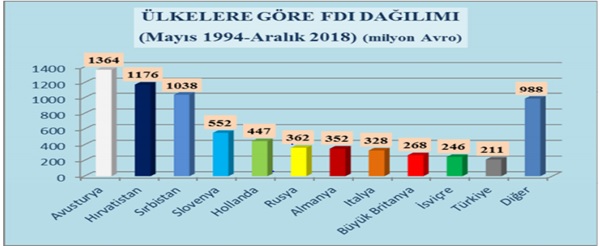
Source: Republic of Turkey, Ministry of Trade
Figure 4

Source: Republic of Turkey, Ministry of Trade
Figure 4 clearly demonstrates that while BiH has always given trade deficit or negative trade balance, Turkey attained trade surplus or positive trade balance between 2000-2019. The balance of trade also proves that BiH has given significant trade deficit in this regard. Thus, Turkey should increase its economic investments for enhancing a better soft power policy in BiH.
Moreover, Turkey’s first priority should be the persuasion of the Serb member of the BiH Presidency, Milorad Dodik to oppose the Pelješac project. As Cem Gürdeniz argues, Turkey should support BiH during the Exclusive Economic Zone meetings between Croatia and Italy.[23] The Turkish Foreign Minister, Mevlüt Çavuşoğlu has also given full support to the BiH’s ambassador, Adis Alagic, with his meeting in Ankara.[24] Another crucial scholar, Cihat Yaycı argued that there is still 300 days of period and during this period Pelješac Bridge need to be stopped. Turkey must help Bosnians during the Peace Implementation Council (PIC) meeting for Pelješac Bridge. This project is also not legal according to the UNCLOS since Croatia did not even ask for permission from the BiH Presidency.[25] Moreover, Turkey is also in the Steering Board of the PIC which is the main representative of international community, which nominates and funds the OHR. Therefore, the continuation of Turkey’s soft power in the PIC should be by representing the Organization of Islamic Conference (OIC). Hence, Turkey’s avoidance of being regarded as the sole representer of the Bosnian Muslims’ interests in PIC, should be continued by preserving unity, sovereignty, multi-religious and multi-cultural structure of the country. Turkey also supports BiH’s integration into European and Euro-Atlantic structures.[26] Finally, as an example of hard power, Doğan Güreş, the Chief of Turkish General Staff in 1992-1995, stressed that they provided military assistance to Bosnians through sea channels in which 90% of the weapons were taken by Croatians during the Bosnian war.[27]
Conclusion
Ultimately, the Pelješac Bridge should not be implemented since BiH is legally justified from the UNCLOS. The EU should stop this Balkanization process and should not ignore the sovereignty rights of other countries. Hence, Turkey can stabilize this balance of power in favor of BiH by mediating among conflictual parties. Turkey should also consider Pelješac project as an opportunity to build a modern port in Neum, which will illustrate that BiH does not deny its legal sea rights. Turkey also needs to increase its soft power with economic investments in BiH based on the respective expectations. Moreover, the lack of common consensus in the BiH domestic politics against Pelješac Bridge can be solved by Turkey’s mediation through Russian or Serbian channels. Therefore, there is nothing left for Turkey but to solve this project. Consequently, both BiH and Crotia should consider the Pelješac Bridge as an opportunity to increase their positive transboundary cooperation against EU’s destabilization process.
*This article has been updated on 26 February 2021.
[1] Thomas Bickl, “Bridge over Troubled Waters: The Pelješac Project, China, and the Implications for Good-Neighbourly Relations and the EU,” Politička Misao: Časopis Za Politologiju 56, no. 3–4 (2019): 50–78, https://doi.org/10.20901/pm.56.3-4.03
[2] “Infrastructure,” Županija Dubrovačko Neretvanska, 2021, http://www.edubrovnik.org/en/infrastructure
[3] Katerina Kolozova, “How the EU Balkanised the Balkans,” Al Jazeera, 2019, https://www.aljazeera.com/opinions/2019/11/2/how-the-eu-balkanised-the-balkans
[4] “Press Corner,” European Commission, 2019, https://ec.europa.eu/commission/presscorner/detail/en/IP_19_6140
[5] Wikipedia Contributors, “Pelješac Bridge,” Wikipedia, accessed January 21, 2021, https://en.wikipedia.org/wiki/Pelje%C5%A1ac_Bridge
[6] Bickl, “Bridge over Troubled Waters…”
[7] Cem Gürdeniz, “Bosna Hersek ve Akdeniz’e Çıkış,” VeryansınTV, January 17, 2021, https://www.veryansintv.com/bosna-hersek-ve-akdenize-cikis
[8] Vedran Pavlic, “Bosnian Leader: ‘Croatia Cannot Build Pelješac Bridge,’” Total-Croatia News, 2017, https://www.total-croatia-news.com/politics/21198-bosnian-leader-croatia-cannot-build-peljesac-bridge
[9] “Komšić: Nije Sporan Pelješki Most Nego Morska Granica S Hrvatskom,” TPortal.hr, 2019, https://www.tportal.hr/vijesti/clanak/komsic-nije-sporan-peljeski-most-nego-morska-granica-s-hrvatskom-foto-20190717
[10] “Pelješki Most Sarajevo Više Ne Može Ni Pokušati Zaustaviti,” Vecernji.hr, 2019, https://www.vecernji.hr/vijesti/peljeski-most-sarajevo-vise-ne-moze-ni-pokusati-zaustaviti-1333351
[11] “EU: Pelješki Most Se Gradi Bez Obzira Na Komšićevu Prijetnju,” Balkans.AlJazeera.net, 2018, https://balkans.aljazeera.net/news/balkan/2018/10/10/eu-peljeski-most-se-gradi-bez-obzira-na-komsicevu-prijetnju
[12] Bickl, “Bridge over Troubled Waters…”
[13] “IBRU: Centre for Borders Research: Publication - Durham University,” Durham University, 2020, https://www.dur.ac.uk/ibru/publications/view/?id=231
[14] Bickl, “Bridge over Troubled Waters…”
[15] Bickl, “Bridge over Troubled Waters…”
[16] Gülçin Keskin, “Türkiye’nin Bosna Hersek Savaşı’ndaki Politikası,” ResearchGate, 2016.
[17] Birgül Demirtaş, “Ankara ve Berlin’in Bosna Savaşı’na Yönelik Politikaları: Karşılaştırmalı Bir İnceleme,” Uluslararası İlişkiler/International Relations 4, no. 13 (2007).
[18] Birgül Demirtaş, “Ankara ve Berlin’in Bosna Savaşı’na Yönelik Politikaları: Karşılaştırmalı Bir İnceleme,” Uluslararası İlişkiler/International Relations 4, no. 13 (2007).
[19] Jahja Muhasilović, “Turkey’s Soft Power and Public Diplomacy in Bosnia-Herzegovina and Sandžak (2002-2017)”, Union of Turkish World Municipalities, 2020, http://www.tdbb.org.tr/tdbb/wp-content/uploads/2020/12/Jahja-Muhasilovic-30122020-2.pdf
[20] Muhasilović, “Turkey’s Soft Power and Public Diplomacy…”
[21] Republic of Turkey Sarajevo Embassy Commercial Counsellor, “Report of Bosnia and Herzegovina,” Ministry of Trade of the Republic of Turkey, 2020, https://ticaret.gov.tr/data/5b8a43355c7495406a2276af/Bosna%20Hersek%20%C3%9Clke%20Raporu%202020.pdf
[22] Republic of Turkey Sarajevo Embassy Commercial Counsellor, “Report of Bosnia and Herzegovina.”
[23] Gürdeniz, “Bosna Hersek ve Akdeniz’e Çıkış.”
[24] EDSBILISIM, “Cem Gürdeniz Yazdı, Türkiye-Bosna Birleşti,” VeryansınTV, January 20, 2021, https://www.veryansintv.com/gurdeniz-yazdi-turkiye-bosna-birlesti
[25] İyi Hisset Gündem, “Cihat Yaycı: Bosna Hersek’i Koruyalım!”, YouTube, January 23, 2021, https://www.youtube.com/watch?v=Anbi5ba13gQ
[26] Organization of Islamic Cooperation, “Report of the OIC Contact Group on Bosnia and Herzegovina,” Report of the OIC Contact Group on Bosnia and Herzegovina, September 25, 2010, https://www.oic-oci.org/topic/?t_id=4297&ref=1841&lan=en
[27] Birgül Demirtaş, “Ankara ve Berlin’in Bosna Savaşı’na Yönelik Politikaları: Karşılaştırmalı Bir İnceleme,” Uluslararası İlişkiler/International Relations 4, no. 13 (2007).
© 2009-2025 Avrasya İncelemeleri Merkezi (AVİM) Tüm Hakları Saklıdır
Henüz Yorum Yapılmamış.
-
 THE FINAL COUNTDOWN TO SAVE THE OTTOMANS’ LAST LEGACY IN BIH FROM THE ENCIRCLEMENT OF PELJESAC BRIDGE
THE FINAL COUNTDOWN TO SAVE THE OTTOMANS’ LAST LEGACY IN BIH FROM THE ENCIRCLEMENT OF PELJESAC BRIDGE
Senad SEVDİK 22.02.2021 -
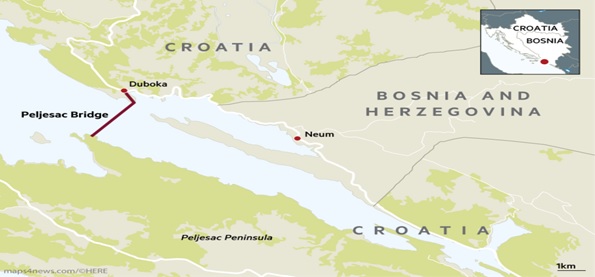 OSMANLI’NIN BOSNA-HERSEKTE’Kİ SON MİRASINI PELJESAC KÖPRÜSÜ’NÜN KUŞATMASINDAN KURTARMAK İÇİN SON FIRSAT
OSMANLI’NIN BOSNA-HERSEKTE’Kİ SON MİRASINI PELJESAC KÖPRÜSÜ’NÜN KUŞATMASINDAN KURTARMAK İÇİN SON FIRSAT
Senad SEVDİK 26.02.2021 -
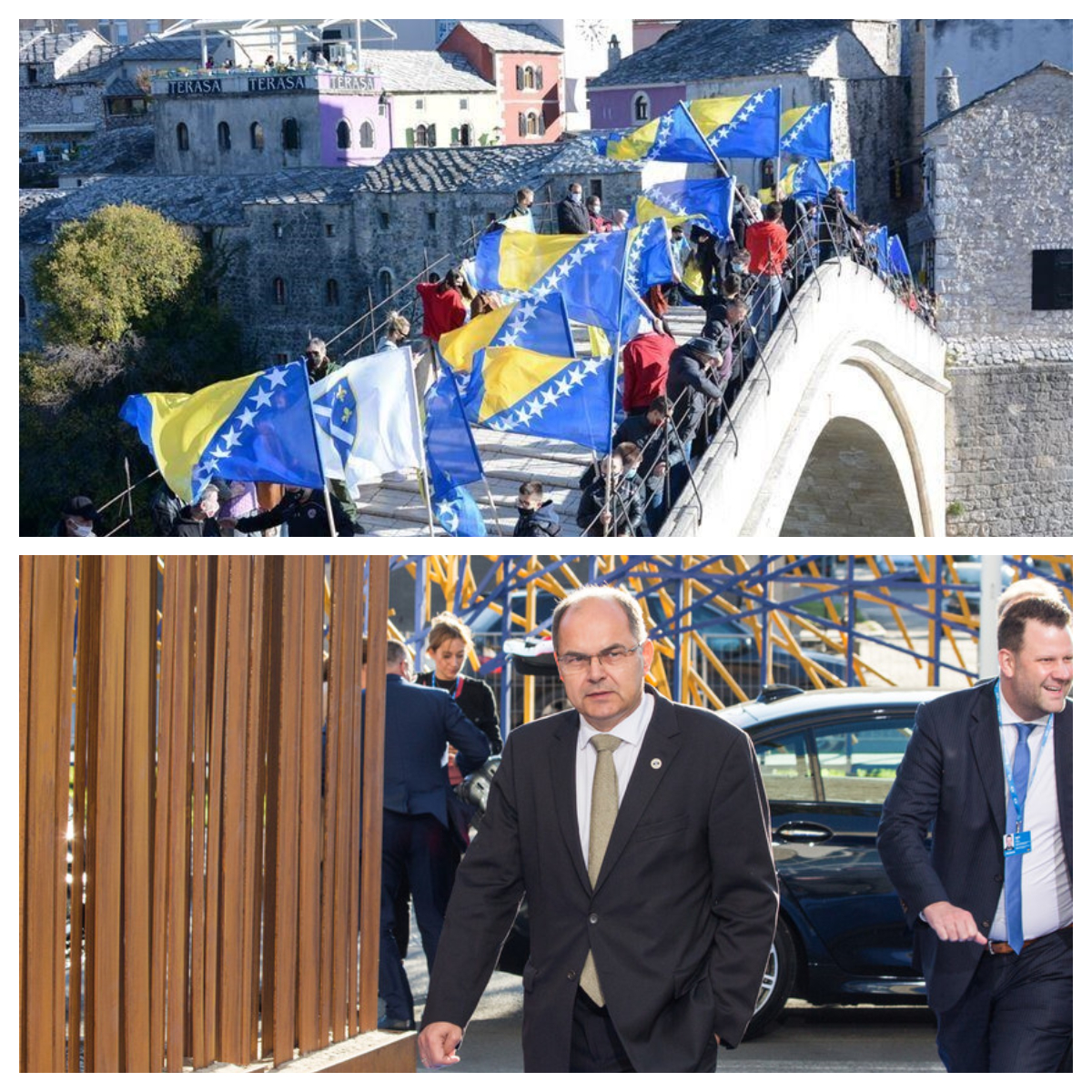 ALMANYA’NIN BOSNA-HERSEK’TEKİ YÜKSEK TEMSİLCİ ADAYI, CHRİSTİAN SCHMİDT VE ONUN MUHTEMEL BONN YETKİLERİNİ KULLANMASI - 02.05.2021
ALMANYA’NIN BOSNA-HERSEK’TEKİ YÜKSEK TEMSİLCİ ADAYI, CHRİSTİAN SCHMİDT VE ONUN MUHTEMEL BONN YETKİLERİNİ KULLANMASI - 02.05.2021
Senad SEVDİK 05.05.2021 -
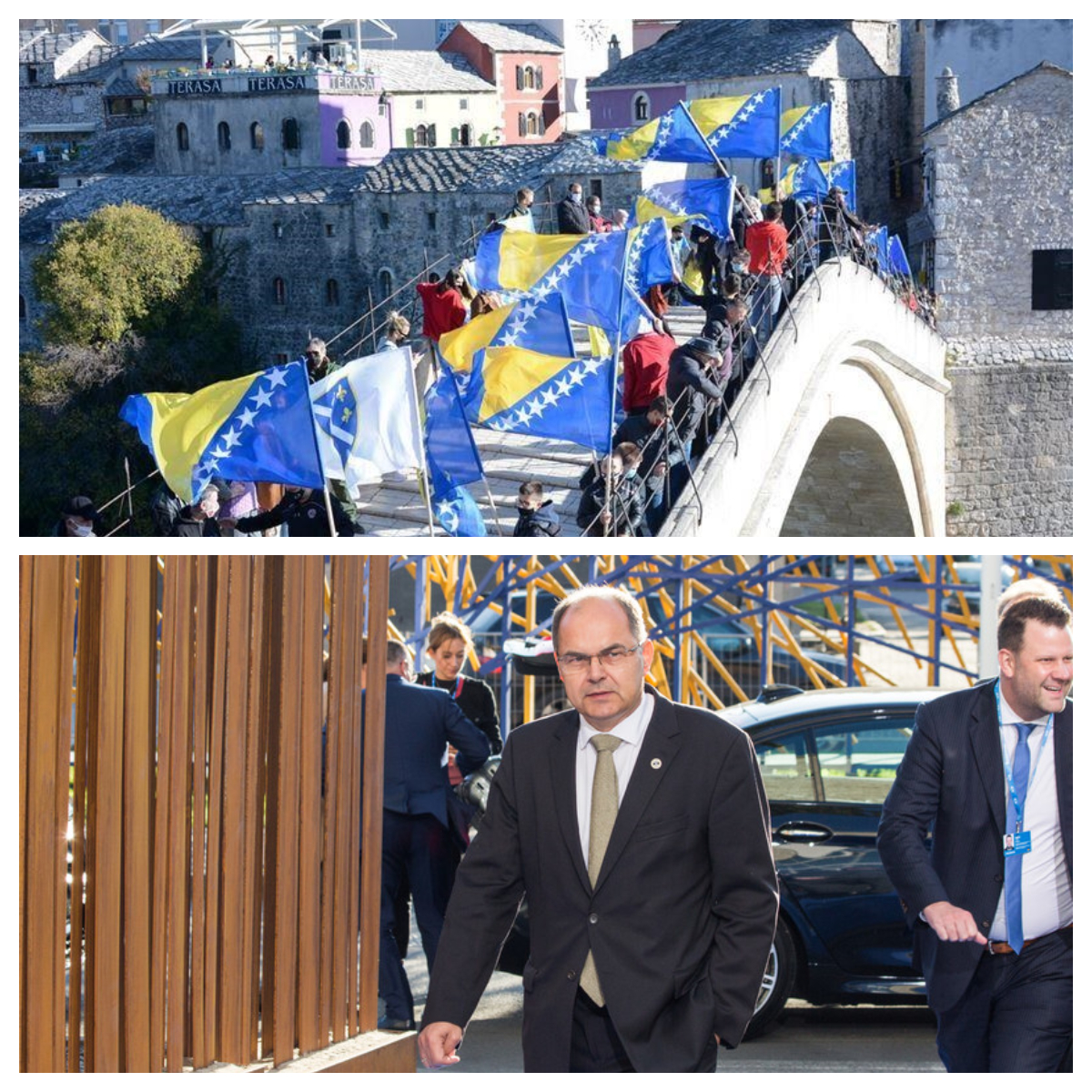 GERMANY’S HIGH REPRESENTATIVE CANDIDATE IN BIH, CHRISTIAN SCHMIDT, AND HIS POSSIBLE USE OF BONN POWERS - 07.04.2021
GERMANY’S HIGH REPRESENTATIVE CANDIDATE IN BIH, CHRISTIAN SCHMIDT, AND HIS POSSIBLE USE OF BONN POWERS - 07.04.2021
Senad SEVDİK 26.04.2021
-
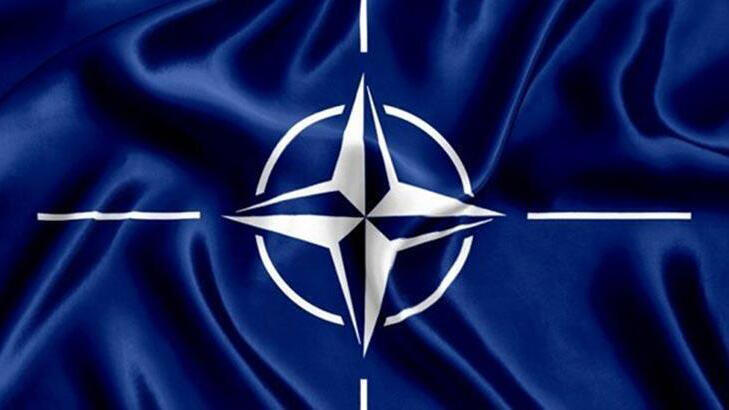 FRANSA DURMAKSIZIN NATO'YU YIPRATIYOR - HÜRRİYET DAILY NEWS - 05.09.2020
FRANSA DURMAKSIZIN NATO'YU YIPRATIYOR - HÜRRİYET DAILY NEWS - 05.09.2020
Teoman Ertuğrul TULUN 10.09.2020 -
 WHY IS MACRON SKEPTICAL ABOUT PLAYING ODE TO JOY FOR THE BALKANS? - HÜRRİYET DAILY NEWS - 01.05.2018
WHY IS MACRON SKEPTICAL ABOUT PLAYING ODE TO JOY FOR THE BALKANS? - HÜRRİYET DAILY NEWS - 01.05.2018
Teoman Ertuğrul TULUN 02.05.2018 -
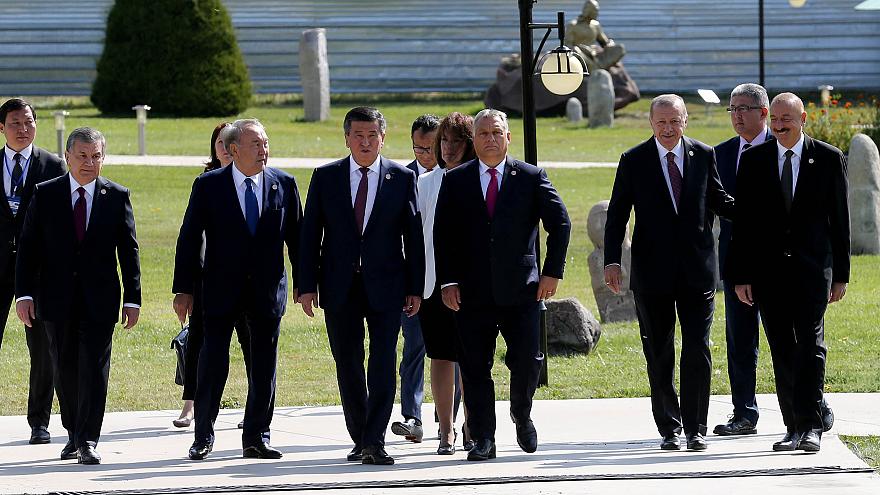 HUNGARIAN RHAPSODY FOR TURKIC COUNCIL - HÜRRİYET DAILY NEWS - 05.10.2018
HUNGARIAN RHAPSODY FOR TURKIC COUNCIL - HÜRRİYET DAILY NEWS - 05.10.2018
Teoman Ertuğrul TULUN 08.10.2018 -
 AVUSTURYA'NIN İLHAKI'NIN 80. YILDÖNÜMÜ: AŞIRI-SAĞ YÜKSELİRKEN AVRUPA DEĞERLERİNİN ÇİĞNENMESİ - DAILY SABAH - 04.04.2018
AVUSTURYA'NIN İLHAKI'NIN 80. YILDÖNÜMÜ: AŞIRI-SAĞ YÜKSELİRKEN AVRUPA DEĞERLERİNİN ÇİĞNENMESİ - DAILY SABAH - 04.04.2018
Teoman Ertuğrul TULUN 17.04.2018 -
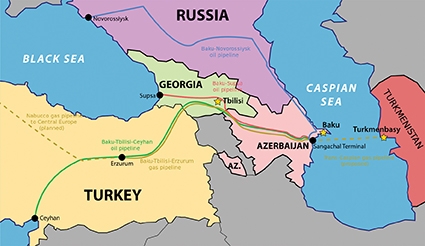 THE ARMENIAN LESSON - GEORGIA TODAY - 16 NOVEMBER 2017
THE ARMENIAN LESSON - GEORGIA TODAY - 16 NOVEMBER 2017
Zaza Jgarkava 17.11.2017


